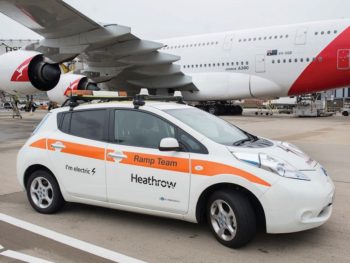Case Study: Mapping Heathrow’s Electric Fleet
With entries now open for this year’s Energy Saving Trust Fleet Heroes awards, we take a look back at the innovations that earned last year’s winners top honours.
Businesses based on a single site are arguably the ideal customers for electric vehicles, as the biggest objection to EVs – range anxiety – is largely eliminated.
Introducing EVs to the fleet of Heathrow Airport, therefore, seems a no-brainer. The second busiest airport in the world, based on a site west of London that covers just under four and three-quarter square miles, has started to embrace the EV revolution, with an initial 57 full electric and plug-in hybrid vehicles on its fleet.
Andrew Chen, head of emissions strategy at Heathrow, told us how the airport has taken its first steps to rolling out EVs to its fleet: “We gradually started introducing these vehicles to various departments, to familiarise our colleagues with the concept and ensure that the vehicles were fit for purpose. We worked closely with vehicle manufacturers, to test a range of vehicles before selecting the most suitable models for our teams.”
However, charging has also been an important consideration for Heathrow. As part of the airport’s plan for sustainable growth, which it calls Heathrow 2.0, it has invested £4m in establishing a charging infrastructure.
“To start, we identified compatible vehicles and chargers, which worked with our limited operational downtime,” Chen said. “This was then cross-checked against the availability of electricity in the areas concerned and an infrastructure map was created, with key areas prioritised.”
Heathrow’s 24/365 operations are challenging for any fleet use, but particularly when that fleet includes EVs. Chen said: “We’re working with much less vehicle downtime and knew that we needed to explore rapid charging options for our fleet. Concerns arose about vehicle range, so we worked to familiarise our colleagues with the charging units and educate them on vehicle range. For example, our newest addition to our fleet, the Renault Zoe, has a range of 200 miles. By doing this and introducing a maximum charge time, we’ve countered issues with unnecessary overcharging and charger availability.”
Following a thorough procurement exercise, Heathrow chose APT Controls Group as its preferred supplier, as the airport needed to fit both AC and DC chargers. Installing the chargers was a straightforward process, according to Chen: “Our development and engineering teams worked closely with our contract installation team to find innovative charging solutions that deliver for our operation.”
With the installation of the first units now complete (it will be an ongoing process as Heathrow seeks to make all the vehicles on its sub 2.4-tonne fleet electric or plug-in hybrid by 2020), there are currently 79 charging sockets around the airport, both airside and landside, ranging from 7kW and 22kW AC to 50kW DC rapid charge units, deployed based on available power and how long vehicles are typically stopped there. Efforts which were recognised at the Energy Saving Trust’s Fleet Hero awards last year.
But this is merely the start: Heathrow already has plans for how it will continue on the path to EV integration in the coming years, along with the installation of charging units to service those vehicles. Chen told us: “Heathrow has the highest density of electrical vehicle charging infrastructure in Europe, was one of the first companies to sign up to EV100, which takes Heathrow’s commitment to electric technology further by committing to turning all large vans (and half of its HGVs) electric or plug-in hybrid by 2030.
“We’re also encouraging our partners to do the same. Through our Clean Vehicles Partnership, we work with fleet operators at the airport to promote the uptake of electric and sustainable fleets and provide guidance on how to reduce emissions. We’ve already seen the introduction of electric ground support equipment (GSE), baggage tugs and ramps on the airfield. We’re also working towards introducing airside vehicle emissions standards aligned with London’s Ultra Low Emission Zone (ULEZ) by 2025.”
With such a start to its integration of EVs and chargers into its operations, it might be fair to say that the sky’s the limit.
Be a Fleet Hero:
Taking place on 27th November, The Fleet Heroes Awards seeks to recognise the organisations delivering cleaner, more efficient fleets through innovation, technology and fresh approaches to transporting people and goods.
To enter, submit your application via http://fleetheroes.org.uk/enter-now before 1 October.













